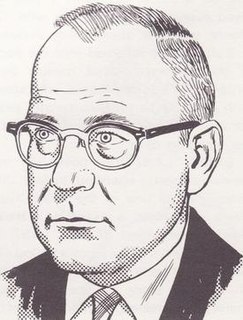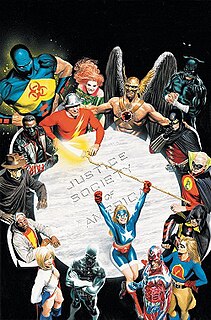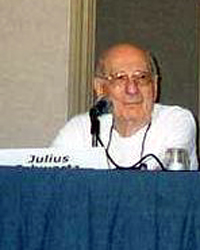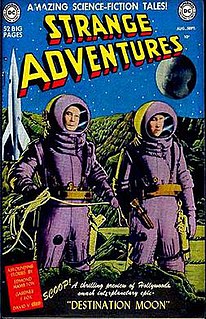
The Flash is the name of several superheroes appearing in American comic books published by DC Comics. Created by writer Gardner Fox and artist Harry Lampert, the original Flash first appeared in Flash Comics #1. Nicknamed the "Scarlet Speedster", all incarnations of the Flash possess "super speed", which includes the ability to run, move, and think extremely fast, use superhuman reflexes, and seemingly violate certain laws of physics.

Gardner Francis Cooper Fox was an American writer known best for creating numerous comic book characters for DC Comics. He is estimated to have written more than 4,000 comics stories, including 1,500 for DC Comics. Fox was also a science fiction author and wrote many novels and short stories.

The Justice Society of America (JSA) is a superhero team appearing in American comic books published by DC Comics. The team was conceived by editor Sheldon Mayer and writer Gardner Fox during the Golden Age of Comic Books. The JSA first appeared in All Star Comics #3, making it the first team of superheroes in comic books. The original members of the Justice Society of America were Doctor Fate, Hourman, The Spectre, Sandman, Atom, Flash, Green Lantern, and Hawkman.

Julius "Julie" Schwartz was a comic book editor, and a science fiction agent and prominent fan. He was born in The Bronx, New York. He is best known as a longtime editor at DC Comics, where at various times he was primary editor over the company's flagship superheroes, Superman and Batman.
John Broome, who additionally used the pseudonyms John Osgood and Edgar Ray Meritt, was an American comic book writer for DC Comics.

Flash Comics is a comics anthology published by All-American Publications and later by National Periodical Publications. The title had 104 issues published from January 1940 to February 1949. Despite the title, the anthology featured the adventures of multiple superheroes in addition to Jay Garrick, the original Flash. Characters introduced in the series include the Flash, Hawkman, Hawkgirl and Black Canary.

All Star Comics is an American comic book series from All-American Publications, one of three companies that merged with National Periodical Publications to form the modern-day DC Comics. While the series' cover-logo trademark reads All Star Comics, its copyrighted title as indicated by postal indicia is All-Star Comics, with a hyphen. With the exception of the first two issues, All Star Comics told stories about the adventures of the Justice Society of America, the very first team of superheroes. It also introduced Wonder Woman.

Strange Adventures is a series of American comic books published by DC Comics, the first of which was August–September 1950, according to the cover date, and published continuously until November 1973.

Showcase is a comic anthology series published by DC Comics. The general theme of the series was to feature new and minor characters as a way to gauge reader interest in them, without the difficulty and risk of featuring untested characters in their own ongoing titles. Showcase is regarded as the most successful of such tryout series, having been published continuously for more than 14 years, launching numerous popular titles, and maintaining a considerable readership of its own. The series ran from March–April 1956 to September 1970, suspending publication with issue #93, and then was revived for eleven issues from August 1977 to September 1978.

Carmine Michael Infantino was an American comics artist and editor, primarily for DC Comics, during the late 1950s and early 1960s period known as the Silver Age of Comic Books. Among his character creations are the Black Canary and the Silver Age version of DC super-speedster the Flash with writer Robert Kanigher, the stretching Elongated Man with John Broome, Barbara Gordon the second Batgirl with writer Gardner Fox, Deadman with writer Arnold Drake, and Christopher Chance, the second iteration of the Human Target with Len Wein.

All-Star Western was the name of three American comic book series published by DC Comics, each a Western fiction omnibus featuring both continuing characters and anthological stories. The first ran from 1951 to 1961, the second from 1970 to 1972 and the third was part of The New 52 and ran from September 2011 to August 2014.
Notable events of 1959 in comics. See also List of years in comics.
Notable events of 1948 in comics. See also List of years in comics.
Robert Kanigher was an American comic book writer and editor whose career spanned five decades. He was involved with the Wonder Woman franchise for over twenty years, taking over the scripting from creator William Moulton Marston. In addition, Kanigher spent many years in charge of DC Comics's war titles and created the character Sgt. Rock. Kanigher scripted what is considered the first Silver Age comic book story, "Mystery of the Human Thunderbolt!", which introduced the Barry Allen version of the Flash in Showcase #4.

Mystery in Space is the name of two science fiction American comic book series published by DC Comics, and of a standalone Vertigo anthology released in 2012. The first series ran for 110 issues from 1951 to 1966, with a further seven issues continuing the numbering during a 1980s revival of the title. An eight-issue limited series began in 2006.
Cary Bates is an American comic book, animation, television and film writer. He is best known for his work on The Flash and Superman.
Notable events of 1947 in comics. See also List of years in comics.

The Flash is an ongoing American comic book series featuring the DC Comics superhero of the same name. Throughout its publication, the series has primarily focused on two characters who have worn the mantle of the Flash: Barry Allen, the second Flash, and Wally West, the third Flash. The series began at issue #105, picking up its issue numbering from the anthology series Flash Comics which had featured Jay Garrick as the first Flash.

The 1940s were an essential time for DC Comics. Both National Comics Publications and All-American Publications would introduce many new featured superheroes in American comic books in superhero comics anthology tales like More Fun Comics, Adventure Comics, Detective Comics, Action Comics, All-American Comics, Superman, Flash Comics, Batman, All Star Comics, World's Finest Comics, All-Flash, Star Spangled Comics, Green Lantern, Leading Comics, Sensation Comics, Wonder Woman, Comic Cavalcade and Superboy that would be a staple for the comic book company. Examples of the superheroes include the Flash, Hawkman and Hawkgirl, Johnny Thunder and Thunderbolt, Spectre, Hourman, Robin, Doctor Fate, Congo Bill, Green Lantern, Atom, Manhunter, Doctor Mid-Nite, Sargon the Sorcerer, Starman, Johnny Quick, the Shining Knight, the Star-Spangled Kid and Stripesy, Tarantula, Vigilante, Green Arrow and Speedy, Aquaman, Wonder Woman, Sandy, the Golden Boy, Mister Terrific, Wildcat, Air Wave, Guardian, Robotman, TNT and Dan the Dyna-Mite, Liberty Belle, Superboy and Black Canary. These characters would later crossover in superhero team titles in the 1940s such as the Justice Society of America and the Seven Soldiers of Victory helping pave a way to a shared universe of the publication company. Other used featured characters outside of superheroes included kid titular heroes like the Newsboy Legion and the Boy Commandos. Later Western heroes would be used such as Johnny Thunder, Nighthawk and Pow Wow Smith.

Black Canary is a fictional superheroine appearing in American comic books published by DC Comics. Created by the writer-artist team of Robert Kanigher and Carmine Infantino, the character debuted in Flash Comics #86 as the first Black Canary in the Golden Age of Comic Books. Strong, mysterious, gutsy and romantic, she has been called "the archetype of the new Film Noir era heroine."














